What tiles to put on the floor of a small kitchen. Linoleum is the most practical and cheapest option. Polymer vinyl tile
Greetings, dear readers, today we want to talk about such a difficult topic as the choice of flooring in the kitchen. What is better to put on the floor in the kitchen - this question is asked by all those who decide to make repairs in the kitchen. And there really is something to think about - in the kitchen flooring will face aggressive external influences, whether it be strong temperature changes, high humidity, various smells and physical influences, in the form of fallen plates and spoons. And such a floor should still be easy to operate and maintain, right? Like this not an easy task stands in front of us. If you do not want your floor to become unusable within 1-2 years, we recommend that you carefully read our article to the end.
First, we will get acquainted with the most popular types of flooring, consider their pros and cons, and then choose the option that best suits our criteria.
Let's look at what advantages our floor should ideally have:
- Moisture and water resistance. A spilled soup, a dropped mug of water, or just boiling water in a pot is something our flooring will encounter every day.
- Safety and hygiene. Resistant to the use of aggressive detergents.
- Durable and wear-resistant material. Keeping it attractive appearance for many years.
- Resistance to physical influences. Unfortunately, most materials do not have the necessary strength.
We've got quite a list, haven't we? The coating we choose must meet at least two requirements from this list. But in addition to these certainly useful qualities, you must also take into account the price of the product and its appearance.
Ceramic tile
Advantages of tiles as a floor covering:
- Beautiful appearance.
- Resistant to moisture and water.
- It is not afraid of external aggressive influences - detergents, solar activity, fats and temperature changes.
- Does not deform and practically does not lose its appearance.
- Quick and easy cleaning.
As you can see, the advantages are quite significant and we suggest that you take note of this option.
Kitchen tile examples
But before you opt for this material, we suggest that you familiarize yourself with the disadvantages of flooring:
- Ceramics do not tolerate heavy physical impact, for example, if a cast-iron pan is dropped, the tile will probably crack. Stone tile is much more impact resistant, but it has a significant drawback - the price.
- Dropped dishes in 95% of cases will not survive the impact and will break.
- The coldest coating, barefoot on ceramic tiles is not very comfortable. Warm under tile - in this article you can read which underfloor heating is best suited for tile and how to install it. If a warm floor is not suitable for you, then you can lay a carpet on the floor.
Parquet flooring
Now let's talk about such a wonderful coating as a parquet board. We described in great detail all the pros and cons in the article - “Parquet or laminate? What's better? ". Here we briefly review the main pros and cons.
Let's start with the pros:
- Wooden flooring creates a unique coziness in the kitchen.
- Wood floors are warm and comfortable.
- A huge variety of colors, textures and styling methods.
- Environmental friendliness.
- Moisture resistance, but only in a short period of time.
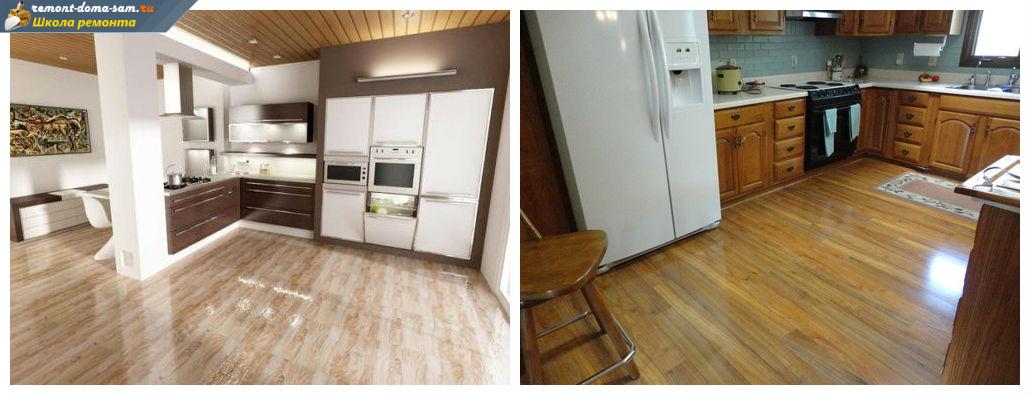
Parquet board looks beautiful and expensive
And now let's talk about the disadvantages of parquet boards:
- Afraid of prolonged contact with water (several hours).
- Strong physical influences can leave marks on the coating and restoration of the canvas will be required.
- The main disadvantage is the high price compared to other types of coatings.
Laminate in the kitchen
In this article, we will not touch on expensive types of laminate, which include class 31-33, which has increased wear and moisture resistance. You can familiarize yourself with the advantages of laminate in detail in the article - “Choosing a laminate”. Here we briefly review the main advantages and disadvantages of the coating.
Benefits of laminate:
- Imitation of other floor coverings - tiles, wood, etc.
- Low price of the product.
- Not afraid of exposure to high temperatures.
- The possibility of replacing the damaged area.

Laminate in the kitchen
Cons of laminate in the kitchen:
- Synthetic material, not natural.
- Under the influence of water and moisture, it deforms and swells.
- Cheap models are very easily damaged.
- A real dust collector - synthetics are electrified and attract dust.
- It is afraid of exposure to cleaning agents and easily gets dirty.
Project owner advice. Dear readers, I have laminate flooring in my kitchen and I strongly recommend that you do not use this coating in the kitchen. Grease stains are hard to rub off, the corners of the laminate are chipped in some places, and the coating is swollen in some places. Unfortunately, the apartment was bought with such a coating in the kitchen and the laminate was of poor quality. More expensive models don't have this problem. As soon as possible, the coating will be replaced with a more suitable one.
Linoleum - the most practical and cheapest option
We talked about linoleum in detail in the article - "laminate or linoleum". Here we will touch on the main advantages and disadvantages of the coating. In the same category we include PVC tiles, which have the same characteristics and properties as linoleum.
First about the pros:
- Excellent water resistance.
- Wear resistance.
- Not afraid of falling heavy objects.
- Cheap product price.
- Soft and warm.
- A wide range of colors and patterns (see photos).
- Easy to clean and wash.

Variety of colors and patterns
Now let's talk about the cons:
- Afraid of exposure to high temperatures.
- Afraid of caustic cleaning products.
- There is a possibility of tearing or cutting the coating.
- It fades and attracts dust.
- Synthetics.
In fairness, it is worth noting that all these disadvantages relate to vinyl coatings, while real linoleum, the so-called marmoleum, is devoid of these disadvantages. Unfortunately, natural linoleum is much more expensive than a synthetic counterpart.
We recommend that you combine flooring in the kitchen, using the strengths of each flooring. In addition to practicality, you can visually divide the kitchen into two zones, for example, into a cooking and eating area. It is very practical to lay tiles near the stove and sink, and in the place where it will be dinner table, lay parquet or good laminate. Let's take a closer look at what you need to know when zoning a kitchen. This option is also great for the hallway.
- Surfaces suitable for the cooking area: ceramic and stone tiles, PVC tiles and linoleum.
- Coatings suitable for the dining area: parquet, laminate, bamboo flooring.
- The thickness of the coatings must be the same.
- It is very important to make a beautiful transition of two floor coverings, we talked about this in detail in the article - "How to join parquet and tiles".
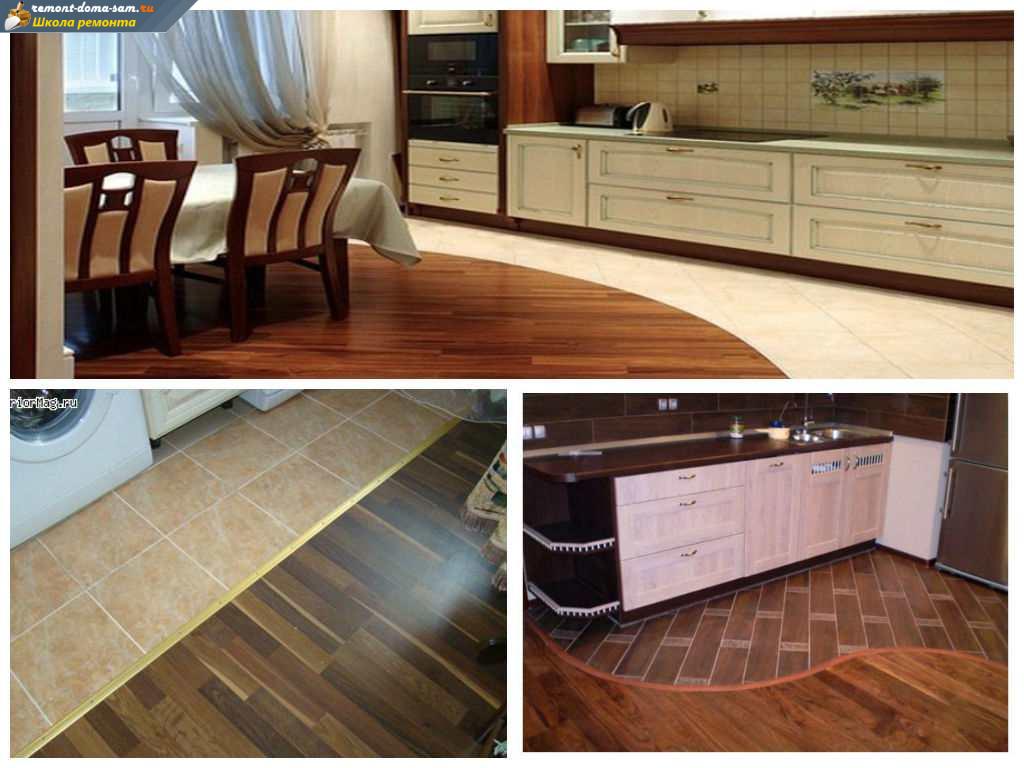
Combination is the best option
Dear readers, I hope you liked our article, please click on one of the buttons social networks under the video, by doing this you help the resource develop. Thank you for your attention, see you in the next article.
Video
In contact with
During repair work, many owners think about what kind of kitchen. Indeed, the variety of goods on the shelves of hardware stores will mislead anyone.
Glass tiles look great not only on the walls
So, let's find out!
Requirements for the floor in the kitchen
First of all, let's find out what requirements the kitchen floor should meet:
- The cover must be comfortable;
- Be hygienic;
- High level of environmental friendliness;
- The floor must be low-abrasion;
- The floor must be washable and non-slip.
So, the requirements are listed, now let's move on to the tiled finishes.
Ceramic tile
- a great option. Moreover, you can purchase both glazed and unglazed versions. The unglazed type is even more preferable because it most often has a “rough” surface that prevents slipping. Most often, floor options differ in relief and textural structure.
What I would like to save from: when considering which tiles to put on the floor in the kitchen, do not opt for porous options. Anyway, in the kitchen, something can spill on the floor, oil or wine, and then the tile will be hopelessly damaged, since it will be problematic to pull out the pollutant.
In addition, it is advisable to choose a tile that is not very large, because the more joints, the less slippery the floor will be.
According to the production method, tiles are divided into:
- extruded. This type is made by extrusion, that is, through the hole, the mass is squeezed out to the surface, and then it is fired;
- Pressed. The composition of the solution includes special binders, fillers. The mixture is poured into the mold, then it is fed into the unit, where it is pressed, and only then it is fired in a special furnace.
By type of processing, the choice of tiles for the kitchen can come from the following options:
- Monoporosis. The production method includes single firing and then glaze coating. The tile will not be durable, so it is not suitable for the floor;
- Monocottura. And this type of coating is created by pressing, and then single firing. Quite a strong tile;
- Bicottura. It differs from monocottura only in that it provides for double firing, but this does not mean that the quality is improving. The tile turns out to be porous, and the fortress is not up to par;
- Clinker. This type of production is also called extrusion. When thinking about which tile to put on the floor in the kitchen, if you have money, opt for it, since such a tile does not absorb liquid, does not respond to temperature changes, and is resistant to detergents. Clinker is a range of materials that are mixed with fired clay and colorants. The mixture is then forced through a mould, then the mass is extruded and finally fired.
Here are the options, knowing about which will help you in choosing a tile.
Porcelain stoneware
A great option for any floor covering -. This tile is produced by pressing, it does not have a glazed surface, due to which it does not slip at all.
Among the undeniable advantages:
- Significant service life;
- Environmental friendliness;
- Ease of operation;
- Resistance to UV rays, mechanical and chemical influences;
- Various colors;
- Moisture resistance.
But there are also a number of disadvantages:
- With a point force impact, there is a possibility of a split;
- Coldness of the coating;
- In the presence of a glazed surface - wet tiles can slip;
- The need for alignment.
Think about the pros and cons, and decide what kind of tiles to put on the floor in the kitchen.
Metlakh tiles
Despite the fact that it refers to unglazed ceramics produced by pressing, they are classified as separate types. This is a rather expensive type of cladding, but the owners have the opportunity to create a whole work of art on the floor. Metlakh tile perfectly resists abrasion.
Polymer vinyl tile
One of the interesting types demanded by the type of floor cladding. It is something like linoleum tiles, only stronger.
Among the cons:
- Instability to exposure to fatty solutions;
- Medium resistance to chemicals (detergents, abrasives, etc.).
And even the fact that this type of tile can be created with two or three layers does not make it any better than classic tiles. So think twice before choosing this flooring.
glass tile
The latest flooring option to think about when choosing which tiles to put on your kitchen floor. Yes, it does not have excellent resistance to point mechanical impacts, but its shape is perfectly even, it perfectly repels dirt. Due to the fact that the pattern is applied to the inner layer, which is then covered with a transparent coating, the pattern does not fade or wear out.
In addition, some types of such finishes are equipped with built-in LEDs, which gives the finish a special charm.
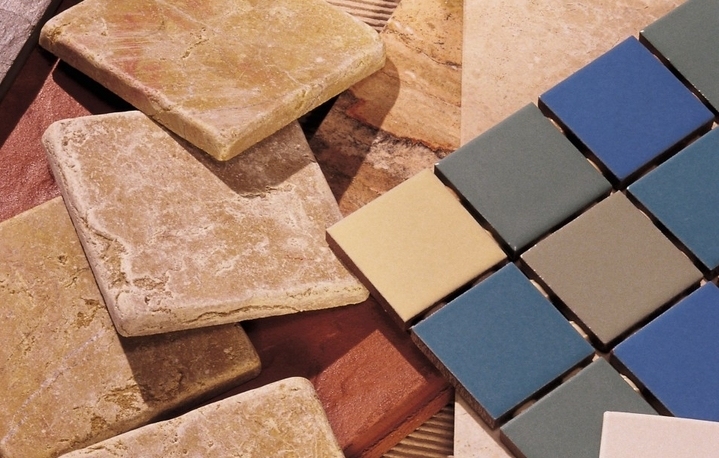
Cladding options
So now you have options to decide which one is in the kitchen. Good luck choosing!
Tiles − right choice hallway flooring. The coating here must be resistant to mechanical and chemical damage. The floor in the corridor is problematic, resistance to the effects of shoe soles, especially heels, is required. In addition, with shoes we bring street dirt, sand, salt. Let's figure out which tile to choose for the floor in the corridor.
Advantages and disadvantages of ceramic coating
The unattractive appearance of the tiled floor is a thing of the past. The current variety of textures, colors, prices allows you to implement any design solutions in the hallway. The corridor expands, lengthens, focuses on the center - as the soul desires. The texture copies a wooden cut, stone, fabric. In terms of fantasy ideas, tile is an excellent material. It remains to decide how to choose ceramic floor tiles.
No parquet and super laminate can be compared with tiles in terms of strength and stability. High performance is undeniable - the tiles are easy to care for, the room is always clean and tidy.
Your interior will visually benefit. It doesn’t matter which tile to choose for the corridor, whether expensive or cheaper, the effect of high cost will definitely play a role. Aesthetically pleasing and neat, the coating can look like many years.
The main disadvantage of ceramics is that they are uncomfortably cold and hard. Barefoot does not make you feel at home. There is a risk of giving the interior a boring mood with a touch of "official". We offer several ways to fight:
- install a floor heating system in the corridor;
- veneer a small fragment near front door. Zoning is relevant for large hallways;
- apply a wood-look tile that imitates cozy parquet.
We make a decision: which tile to choose for the floor in the corridor

Specifications
- Resistance to mechanical abrasion, shock. The load in the hallway is the highest, this negatively affects the condition of the flooring. There is an international division into five classes of wear resistance. Pay attention to the labeling, buy material with the highest rates: REI 4 and REI 5.
- The floor in the hallway is a collection of street debris and dirt. So what kind of tiles to put in the corridor, which requires frequent washing with powerful gels and powders? Maximum resistance to abrasive substances, aggressive household chemicals is marked with the letters AA. It is also possible to cover the floor in the corridor with lining with anti-chemical protection indicators A and B.
- Withstanding wet and dirty shoes will ensure low water absorption. Moisture resistance is achieved during the firing process, for a "corridor" tile, the indicator does not exceed 3%. Visually, we define it as follows: the chip of the material has a red color, a smooth non-porous structure.
- The anti-slip index is taken into account. For tiles in the corridor, the level R10 and R11 is suitable. The coefficient of friction is not lower than 0.75. Before choosing tiles for the floor in the hallway, pay attention to the coverage of the proposed copies. Ideal: matte finish, rough, embossed surface.
Turn away from the beautiful, mirror-like gloss. The slippery surface at hit of the slightest moisture will turn into a real ice rink. After a while, the shine will fade, in visible places it will take on a worn, unsightly look.
Faced with the choice of which tiles to put in the hallway, prefer durable embossed ceramics, indifferent to the effects of water and chemicals.
Size matters
An important question is what size of tiles to choose on the floor. Small tiles are cut less when laying, meaning savings on material. They look cozy.
Large tiles are installed faster and easier. It has fewer seams where moisture, debris, dust get into. Subsequently, these gaps do not look aesthetically pleasing, and the material with low moisture resistance wears out faster.
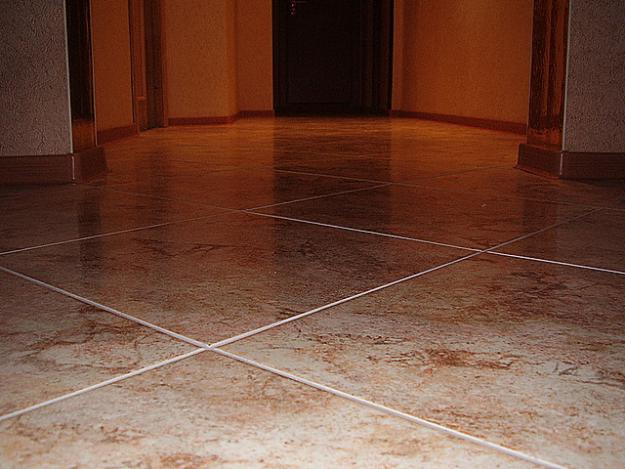
The size of the tile to choose depends on the footage of the room. For a small hallway, use small square shapes. They hide elongation. A large spacious corridor allows you to veneer with imagination, tiles of any size are suitable here, large ceramics look gorgeous.
Attention to color
Light colors are impractical, especially if there is texture. Over time, hard-to-clean dirt-dust will clog into the relief and grout seams. The use of abrasives in this case will adversely affect the coating of the tile.
Let the dark shade not be saturated - possible chips, scratches are too noticeable. Dust is perfectly visible on the black tile.
Cold light colors will make the hallway more spacious, warm ones will give comfort, dark tiles visually limit the space. Find your compromise when deciding which tile to choose for your hallway floor. For example, take a light-colored tile with a colorful pattern in a dark tone.
Choose the color of the tiles in accordance with the color of the coating of the rest of the rooms. Or play on contrasts, strengthening zoning.
Avoid unnecessary brightness. Multicolor visually reduces space. Optimum colors: beige, gray, coffee.
Which tile to put on the floor in the hallway is up to you, but do not forget: the tile pattern must be in harmony with the wall decoration.
![]()
Porcelain stoneware
A common question: which tile to choose in the hallway implies a choice - will it be a tile or porcelain stoneware. The main advantage of the latter is super strength and wear resistance. The manufacturing technology is such that the paint, the pattern is applied through all layers of the tile. Scratches do not spoil the appearance, chips are invisible, since the material has the same color on all levels. The color of porcelain stoneware is simple, monotonous, there is no variety in patterns, like a tile.
Tile layout
When determining which tile to choose for the floor in the hallway, think about the layout method.
- Plain laying in rows is an easy method available. If there are no color solutions, the tile is not original, such styling looks boring. It is convenient to apply for large-sized ceramics.
- Brick, where offset is used - suitable for rectangular shapes. Tiles of different colors are originally combined in such a masonry.


- Parquet laying - for wood-effect ceramics.
- Complex modular installation requires effort and experience. In the center, a pattern is laid out, a drawing around which the rest of the elements are located.
- Beautiful diagonal laying hides wall defects (for example, non-parallelism). Expands space, requires skills from the master.
Lay square tiles in two contrasting colors in a checkerboard pattern. Ordinary in-line masonry, and the effect is amazing!
Combined solutions look interesting on a large area:
- make a border of mosaic tiles;
- lay out the panel in the center of the plot;
- diversify the laying of plain tiles by laying it out in sections at different angles: line up perpendicular walls in the center, turn around with diagonal laying;
- For narrow hallway take a tile of two contrasting colors. The alternation of dark and light stripes will expand the hallway;
- diagonal styling will create the appearance of expanded space.
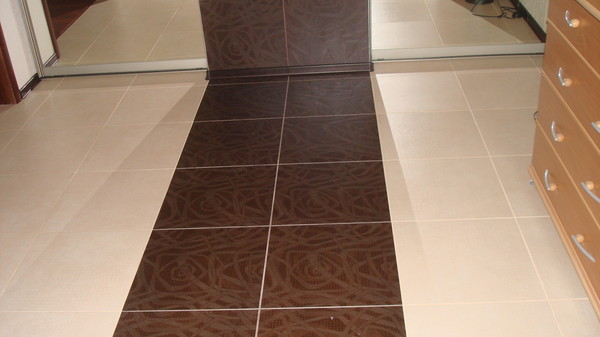

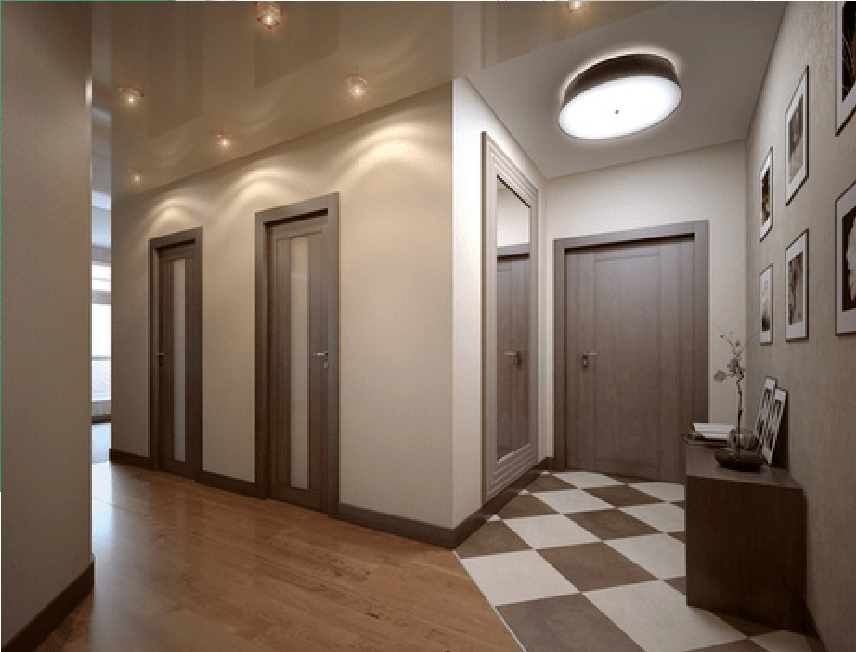

Fresh ideas on the topic: what tiles to put on the floor in the hallway
Zone the room: select a corner for shoes and, separately, a meeting place for guests, laying it out more elegantly.
Move away from hackneyed decisions. Replace standard forms with stylized ones, dilute with mosaics, ceramic decor.
Think about what tiles to put on the floor in the hallway without losing aesthetics. Remember about compatibility with wall decoration.

The combination of tiles and laminate in the hallway looks interesting. A successful variant of zoning without the use of partitions and other structures. Draw a straight line, connect the two coatings with a bend (which is more difficult to implement).
Having figured out what kind of floor tiles to buy in the corridor, do not forget about the ceramic frieze. Plastic plinth along the ceramic floor looks cheap.
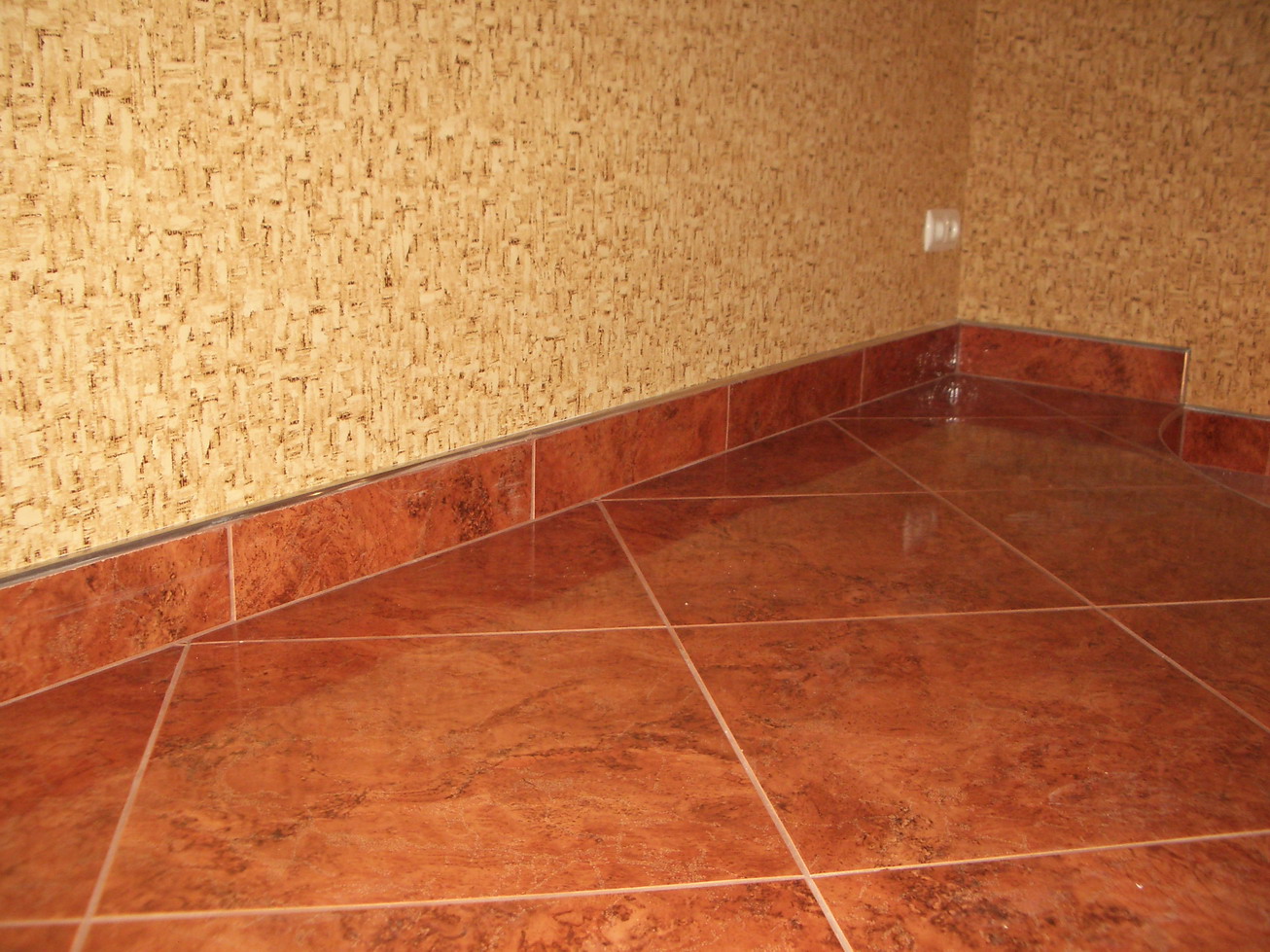
The entrance hall is the first room that everyone who enters the house sees. The question of which tile to choose for the floor in the corridor cannot be reduced to a practical assessment of the technical indicators of durability-strength-stability-slip. Equally important is the aesthetic component, the originality of the flooring design. Do not make a decision alone, ask experienced friends for advice on how to choose a tile for the floor. Consider different opinions to form your own.
Kitchen floor tiles are the highest quality coating material from a practical point of view.
It meets all the requirements for the floor surface:
- wear resistance and strength:
- resistance to temperature changes during operation;
- moisture resistance:
- neutrality to the effects of chemically active detergents:
- fire resistance:
- environmental safety and no release of toxic substances when heated.
The tile is durable and serves without loss of properties, original appearance. You can spoil the coating only by violating the laying technology.
Types of floor tiles, their advantages and disadvantages
The color range of the material has a wide variety. Tiles are produced various types and structures. To determine which tile is better to choose for the kitchen on the floor, a laying specialist will help, based on the base material for the tile and the requirements of the consumer.
Ceramic tiles
The type of coating differs in size, structure, outer coating, thickness, which determines its high strength. Experts advise purchasing tiles of the 3rd or 4th strength class and the 4th or 5th class on the hardness scale.

Ceramic tiles meet all the requirements:
- mechanical bending strength;
- lack of static;
- ease of cleaning and absolute resistance to the means used up to abrasive;
- resistance to ultraviolet rays;
- low cost.
Ceramics allows you to imitate any material. To disadvantages ceramic tiles include:
- low thermal conductivity, which is expressed in lower compared to environment surface temperature;
- low impact strength, leading to cracking when heavy objects fall;
- the complexity of laying, the main difficulty of which is to obtain a flat surface.
Replacement of tiles damaged during operation is carried out without problems. When buying, you need to purchase a small amount of material for a possible subsequent repair. For the kitchen floor, it is preferable to choose matte unglazed tiles with a ribbed surface or corundum coating.
Ceramic tiles
The material is superior in quality to ceramics. Porcelain stoneware has properties:
- high strength, hardness index - 8-9 points out of 10 possible;
- uniformity of color throughout the mass of the material;
- low water absorption, determined by the finely porous structure;
- resistance to mechanical impact.

Porcelain stoneware has wear resistance and durability above ceramic tiles. In addition to the advantages, the material has its drawbacks:
- fragility, which complicates transportation;
- a lot of weight, which must be taken into account when planning its placement on the kitchen floor;
- the complexity of cutting the material;
- high selling price.
The material varies according to the type of surface; for the kitchen floor, porcelain stoneware with a matte surface is mainly selected.
pvc tiles
Installation of PVC tiles is dictated by the ease of installation, for which there is no need to purchase glue. The presence of a self-adhesive surface makes it possible to quickly install the tiles; there are interlocking joints between the tiles.

To the virtues polymer tiles and also include:
- low material cost;
- sensation of warmth upon contact;
- durability;
- soundproofing functions;
- high moisture resistance.
To install PVC tiles, a completely flat surface is required. The disadvantages of tiles are:
- artificial origin of the material;
- combustibility, providing a low level of fire safety.
The material is produced in a variety of colors, which allows you to implement any design solution.
glass tiles
Surfaces created with glass tiles are particularly attractive. According to the characteristics of glass made according to special technologies, not inferior to ceramics.
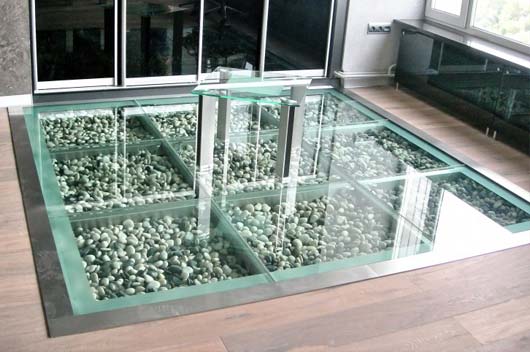
The advantages of glass tiles are:
- strength;
- ease of care;
- the possibility of obtaining an invisible thin seam due to the evenness of the surface;
- no waste of material.
Despite the unreliability of the appearance, glass tiles show resistance to abrasion and the difficulty of causing mechanical damage during operation. The disadvantages of tiles is the high cost of the material. Covering the floor with glass tiles allows you to visually expand the space of the kitchen.
Live 3D tiles
It consists of layers of polycarbonate with a liquid placed between them. Available in various colors that change color upon contact. The tile maintains considerable weight and mechanical loadings.

Advantages of using 3D tiles:
- moisture resistance and ease of cleaning;
- a significant range of ambient operating temperatures;
- the presence of anti-vibration and anti-noise properties;
- environmental friendliness of the material.
As disadvantages, experts cite the requirements for the presence of an absolutely flat base surface, the deviation should not exceed 3 degrees to the horizon.
Installation of tiles on the floor of the kitchen can be made from materials of various strength and visual appearance. All materials are adapted for increased loads of mechanical and thermal properties. The choice of material type depends on the conditions of installation, operation and preferences of the owner of the kitchen.
Sep 3, 2014 Werri 25-02-2015- Ceramic tiles
- Porcelain tiles
- Cotto Kitchen Tiles
- Cottoforte tiles
- Metlakh tiles
- polymer tile
- glass tile
- Varieties of kitchen tiles
- kitchen floor requirements
Today, the variety of floor tiles in the kitchen cannot leave anyone indifferent. Color solutions, images, textures, materials - all this allows you to realize the most unique and daring ideas in kitchen design.

Choosing tiles for the kitchen should be guided by where it will be laid, for the floor it is better to choose hardened and durable materials, and for the backsplash you can choose tiles based on color schemes or corrugated patterns.
Floor tiles in comparison with the wall has more advanced characteristics. So, it is characterized by increased protection against abrasion and durability. Any housewife has a question, which tile to lay on.
Ceramic tiles
Floor tiles for the kitchen also have such a feature as the presence or absence of a glazed layer on the surface. The process for producing unglazed tiles is quite simple. Such a product is characterized by a uniform structure, and dyes give it color. As for glazed tiles, their composition is less uniform. On top of the tile is covered with a glossy layer, which gives it more strength. Some models have applied drawings and images to give a more original look. Floor tiles can also be textured, embossed and smooth.
Floor tiles according to the production method are divided into:

- Extruded, which is made by extrusion. In this case, the mass is squeezed out through a special profile hole and acquires the desired shape. Then she gets burned.
- Pressed, which is based on a plastic mass, binders and fillers. During the production process, a mixture is poured into special-shaped and sized matrices and pressed on special equipment. Next comes the roasting process.
Ceramic tiles look like plates of various formats that are used for flooring, ceilings and walls. The plates are produced from small squares, called mosaic tiles, to those in which one side has a size of 1 m. It is made from sand, clay and various natural materials.
Ceramic tiles according to the production method are divided as follows:
- Monoporosis. This is a single-fired glazed tile. She's not too strong. Monoporose is used for interior decoration.
- Monocottura. Such ceramic enamel tiles are created by pressing and single firing. It can cover walls and floors. Monocottura has a sufficient degree of wear resistance.
- Bicottura. This tile is also enameled ceramic, produced by pressing, but already by double firing. The structure of the bicottura is porous and not strong enough. The enamel that covers the tile is matte or glossy.
- Clinker, or extrusion technology. Such a tile is quite durable in its structure. She has high technical specifications: does not absorb water, invariable to temperature changes, adapted to hygiene and detergents. Clinker is obtained by mixing materials High Quality with annealed clay and coloring oxides. Then this finished mass is pressed through the intended form. Then it is extruded and fired.
Back to index
Porcelain tiles
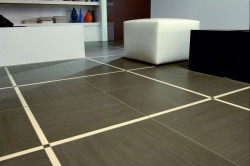
Ceramic tile is quite durable, thanks to this it has a very long service life, and it is also not subject to combustion and is very moisture resistant.
Porcelain stoneware flooring is an excellent solution for a large kitchen, which is decorated in the style of classicism. It is produced by pressing. This tile is waterproof and durable. Porcelain stoneware does not have a glazed layer, as a result of which its surface is non-slip. The component has various kinds of dyes, so the color of the tile can be black, white, and other colors.
Ceramics and porcelain stoneware have a lot in common. For this reason, their advantages and disadvantages are almost identical.
Advantages of porcelain stoneware and ceramics:
- environmental friendliness;
- resistance to chemical and mechanical influences;
- ease of maintenance;
- moisture resistance;
- long service life;
- the possibility of arranging a variety of layouts;
- Fire safety;
- excellent tolerance to UV and sunlight;
- a huge variety of textures, sizes, shapes and colors;
- the possibility of creating underfloor heating.
Cons porcelain stoneware and ceramics:
- cold;
- rigidity;
- the likelihood of a split with a strong impact;
- the glazed surface is slippery when wet;
- the need for a tie.
Back to index
Cotto Kitchen Tiles
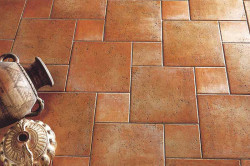
Cotto tiles are used exclusively for interior decoration, and selected types of clay are used for its manufacture.
This type of tile is considered one of the oldest representatives of ceramics. It is produced using extrusion technology from selected clay (it is not stirred before).
Cotto is ideal for country style and is only used for interior decoration. Having a terracotta scale, it harmoniously emphasizes the natural closeness and naturalness. Its surface is unglazed, which requires washing and waxing after laying. If this is not done, then the surface can quickly become stained, which cannot be removed. For the kitchen, it is chosen quite often, despite the fact that this is not an ideal option. But, if properly processed, it will serve for a long time and reliably.
Back to index
Cottoforte tiles
This is a glazed durable tile made from a number of types of clay, including refractory. An opaque glaze is applied to it, and Cottoforte looks amazing on the kitchen floor.
Back to index
Metlakh tiles
Such a product belongs to unglazed ceramics. It is produced by pressing. Metlakh tile is characterized by high strength and wear resistance. Thanks to the variety of designs, it is possible to create whole compositions from a variety of patterns on the kitchen floor.
The surface of the metlakh tile can be either corrugated or smooth. This is ideal for places where there is heavy traffic.
Back to index
polymer tile
The most popular and sought-after tile for the kitchen is PVC.
Disadvantages of polymer tiles:
- poor resistance to fatty substances;
- low strength and resistance to aggressive chemicals and abrasives.
However, this does not prevent its frequent use in the kitchen and hallway. The tile structure can be:
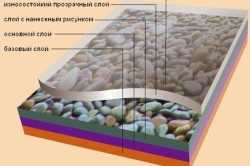
- from one layer;
- from several layers;
- embossed;
- smooth.
Mount such a tile with a special glue or self-adhesive plane. Modern technologies allow you to apply a variety of 3D textures to vinyl surfaces, giving them an excellent imitation of natural materials.
Back to index
glass tile
Glass tiles on the kitchen floor have become a new trend. Since it has an ideal shape, it is easy to mount it. In addition, it has excellent dirt repellency and durability. Manufacturers apply the tile pattern to the inner layer, so it will not burn out or be erased. And thanks to the standard thickness of glass tiles, they can be used with other floor coverings.
Glass tiles with built-in LEDs give a special effect. Despite the fragility of the materials from which it is made, glass tiles are safe, because even with strong impacts, including shock, they do not break.
Back to index
Varieties of kitchen tiles
![]()
Walls from evaporation, moisture, absorption of smells of detergents and foodstuffs are protected by a tile. Floors, on which ceramic tiles are laid, serve as a guarantee of accuracy, health and cleanliness.
There is no unique, rare coating for the kitchen that would meet all the requirements of the hostess. Each material has its own inherent features, complexities and shortcomings. But if you correctly combine materials, you can create a truly exceptional interior. It is very important to take into account the distinctive operational features of the premises.
In the kitchen, it is preferable to use large tiles (50x50 or 30x30), because strong fatty contamination appears during cooking. When using such tiles, it will be convenient to clean the seams between the tiles and from moisture getting on them.
Mosaic or small tiles will perfectly complement the overall pattern of the floor and give the floor a sophisticated look.
It is necessary to pay special attention to the color of the floor in the kitchen. It is necessary to comply with the general color scheme premises. In addition, it must be borne in mind that light colors are difficult to care for, too easily soiled, damage and cracks are perfectly visible on dark coatings. An excellent solution would be the use of heterogeneous coatings with imitation of wood, natural stone or cork.
Humidity is considered the main problem in the kitchen. If water gets on polished and glossy surfaces, they will become slippery, which will be dangerous for absolutely all family members. Even treatment with special anti-slip agents is not able to help. Glossy details are good as decoration elements.



